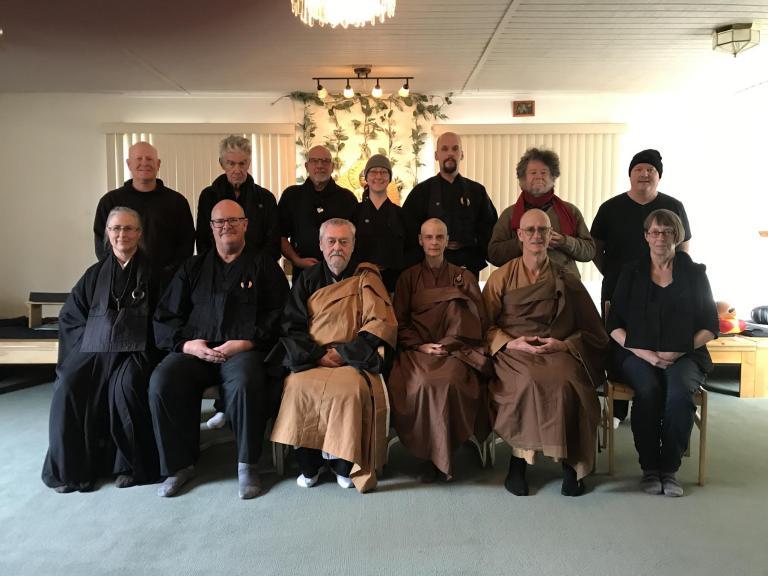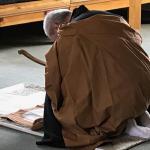The master Baizhang was charged with naming a founding abbot for Mount Daigu. He called his community together and set a full water bottle in their midst. He said, “Don’t call this a water bottle. What will you call it?” The head monk responded, “It’s not a wooden shoe.” Then Baizhang asked the head cook, Guishan, what was his view on the matte? Guishan kicked over the water bottle and returned to his kitchen. Baizhang laughed, and sent Guishan to Mount Daigu.[1]
***
(What follows are some rough notes for a future study. What they sometimes call the crappy first draft. Possibly of interest even in this messy state…)
***
When I first started Zen practice in the San Francisco Bay Area in the late 1960s, the San Francisco Zen Center was already a major Bay Area presence. The renowned Zen missionary Shunryu Suzuki had come to California in 1959 to serve as minister at the long established Sokoji temple. My introduction to Zen practice was at the temple when it was housed in a former synagogue.
What I was not aware of at the time was that there were two communities occupying the same space with the same spiritual leader. What I thought of as the Zen Center was a guest organization of the temple. When I began sitting at their Berkeley branch, they’d already purchased a hot spring resort near Big Sur and were establishing the first formal Zen training temple along Japanese lines at Tassajara. The Berkeley group was one of several practice groups scattered around the Bay.
In 1969 the leadership of Sokoji temple asked for Shunryu Suzuki’s resignation as their priest. Too much of his time was taken up by the expanding needs of the Zen Center and the growing numbers of students. The rest, as they say, is history.
There was a lot I didn’t come to understand until later was that the Zen Center, the actual name “center” was first used by them when they incorporated in 1961, was that the history of Zen communities and even where the focus of practice was, both in the way communities were organized, and who the practitioners were, had evolved over many hundreds of years.
While Zen has always had householder practitioners, the normative place to study and practice from when it first began to emerge in China were within hermitages and monasteries. Sometimes hermitages would become the locus of an emerging monastery. People would hear of a master trying to live quietly and gradually people come to be near and hopefully to study with that master. And another monastery might arise. More often the hermit would remain hidden from fame and gain, living quietly, and dying alone or perhaps in companionship with one or two students. There may or may not be some kind of succession.
While Zen’s literature would suggest there were school specific monasteries, in fact throughout China’s history, monasteries were eclectic things. They might have a meditation hall, but they also might have a chanting hall, and a sutra study hall.
People called into the Buddhadharma would ordain with masters of the monastic rule. Some would devote their lives to understanding the nature of the rule and seek liberation within it. While some would devote their lives to the study of ancient texts they’d received from India, and which seemed to keep appearing. Others would feel the call of Amitabha and find a life devoted to calling on the sacred name. While still others might throw their lives into the disciplines of the meditation all.
Abbots of these monasteries might come from any of these schools. And it was common, and actually, where the monasteries exist in China and on Taiwan, the succeeding abbot can and might well come from another school. Householders, for most of Chinese history, mainly drawn from the scholar bureaucrat class, among the few with leisure time to devote to interests beyond survival, would visit the monasteries. Some among them would become meditators, take up the disciplines of Zen, and on occasion awaken, and sometimes be acknowledged as masters in their own right.
But mostly, Zen belonged to the monasteries and hermitages.
And then Zen came to Japan. There Buddhism began to specialize and what we can think of as specific schools would eventually have their own monastic complexes. But this took a while. And Zen was first practiced in Japan by monastics from the Tendai school. Tendai took a comprehensive view of the dharma, seeing itself as offering a reconciliation of the different approaches.
And so, the earliest Japanese monastics who were attracted to Zen, most notably the Rinzai founder Myōan Eisai and not much later the Soto founder Eihei Dogen, were both first Tendai monks. Eisai may never have thought of himself as anything but. However, Japanese Buddhism also quickly began to form school specific monasteries. Dogen most famously, while rhetorically rejecting sectarianism was among the first to functionally establish a totally Zen specific monastery, Eiheiji.
However, something else happened in Japan which would forever change how Zen would manifest. With a series of Imperial decrees beginning in 1603 Japan instituted what would evolve into rough denominational structures with head temples and branches. These branches often had one or two resident monks. Over time they came to function as parishes serving the liturgical religious needs of the local community. In effect monks gradually became parish priests.
In Japan ordination followed a different system than the Vinaya and had a looser formal statement about celibacy. They were understood to be monks or nuns, but at least in the case of monks in these temples, eventually many had lifelong companions, usually called housekeepers. And over time children. This would come to a head in 1868 when the Imperial court removed all criminal penalties for clerical marriage.
What gradually happened was that temples became largely hereditary. Increasingly what happened is that aspirants to their father’s temple were expected to spend a period of formation at the lineage’s head temples. Gradually Training Temples became normative, where while some people would spend their entire lives there, mostly they were seminaries creating priests for the many thousands of local temples.
The San Francisco Zen Center became the paradigm of the next major shift. The people coming to study with him were there specifically to learn the practices and to grow deep with them. What that meant in practice was there was no way these practitioners were going to go to established temples. Instead, it was once again all about practice.
In the thirteenth century Dogen’s rough contemporary, a Pure Land priest named Shinran Shonen married without hiding the fact nor renouncing his clerical status. He said of himself he was “neither a monk nor a layperson.” Functionally he was creating a noncelibate priesthood not unlike Anglican as opposed to Roman Catholic priests.
Many years later Suzuki Roshi used that term when speaking of his students as neither monks nor laypeople. But he meant something different. He was describing the emerging Zen practitioners of North America and the West. And he really meant all them whether they chose to follow in an adaptation of the Japanese ordination model, or, ever more so, simply were householder practitioners.
Where when Zen first began to emerge in medieval China householder practitioners were few and far between, as I noted, usually only highly educated governmental officials. Officials with time they could devote to something beyond bare survival. Now there were few interested in a traditional monastic life as monks or nuns. Some were interested in Zen priest practice as it evolved in Japan. But the real focus was learning to meditate, being guided in going deep in those disciplines, and to a lesser degree establishing Mahayana Buddhist lives. While making their livings outside of a professional Buddhist world.
The Zen center emerged to serve that community. While the San Francisco Zen Center is a major complex with three major branches, the original in San Francisco, the monastery in Tassjara Hot Springs, and the Green Gulch Farm in Marin county. It serves a network of affiliated communities, at this writing with nearly seventy formal sanghas in North America alone, and many more overseas.
This has become something of a pattern for the Zen center system in the West. There are ordained practitioners. There are monastics. There are Zen priests in the Japanese style. Actually, through a separate evolution the Korean Taego Order also includes non-celibate clergy. And they are beginning to have a significant presence in North America and the West. But whatever the tradition, many of these practitioners, most are householders. Another Korean derived lineage, the Kwan Um School of Zen originally saw a two-fold leadership rising, monastics and householder. Over the last decades I’ve watched the numbers of monastics continue to shrink, to the point that today the teachers of their extensive community are nearly entirely householders. Similarly the linage of the late Chinese master Sheng Yen is beginning to have a presence outside of the Chinese community through its householder teachers.
And householder teachers and non-celibate clergy reflect the profound shift in who identifies as a Zen practitioner. Those involved in Zen are not congregants, not, as it were only listeners. They are not passive in their participation. They have regular disciplined spiritual lives. Not exactly monastic. Not precisely lay. They find their practice supported by the centers and smaller sanghas, which often has a leader. The leader may be ordained, but often is not.
Originally sangha was a term reserved for a certain number of monks or nuns. In the Mahayana tradition it quickly became a term for the great community of Buddhists, and even for the great community of life, and beyond that to everything that has emerged.
Now sangha has come to mean those things and the smaller, sometimes fairly substantial, most commonly a handful of people gathered together for practice and mutual support.
Today there are many hundreds of Zen centers and sanghas in many different lineages and traditions, where the majority of the community are householders. Many best described as neither monastics nor laypeople.
A new community of practice and awakening with new institutions to support the practice and practitioners.
[1] Gateless Gate, Case 40, author’s version














